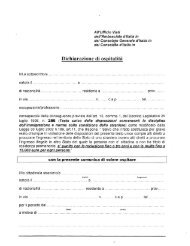Investment in Italy
Investment in Italy
Investment in Italy
- No tags were found...
You also want an ePaper? Increase the reach of your titles
YUMPU automatically turns print PDFs into web optimized ePapers that Google loves.
<strong>Investment</strong> <strong>in</strong> <strong>Italy</strong>be fixed-term only on specific technical, production or organizational grounds or when it istemporarily necessary to replace workers. Otherwise, a fixed-term agreement is consideredas <strong>in</strong>valid and the employment relationship is regarded as <strong>in</strong>def<strong>in</strong>ite.The CCNL establishes the percentage of employees that may be hired on a fixed-term contract.Trial periodThe parties may opt for a trial period. The maximum length is established by the CCNLs andmay not exceed six months.A trial period has to be agreed <strong>in</strong> writ<strong>in</strong>g before the start of employment; otherwise thetrial period is null and void and the relationship is considered as an <strong>in</strong>def<strong>in</strong>ite employmentagreement, runn<strong>in</strong>g from the start of work.Dur<strong>in</strong>g the trial period both the employer and the employee can term<strong>in</strong>ate the employmentrelationship at any time (without any notice and without any <strong>in</strong>demnity).Work<strong>in</strong>g hoursWork<strong>in</strong>g hours are established by the CCNLs and cannot normally exceed 40 hours perweek for employees.There is a statutory m<strong>in</strong>imum overtime rate, equal to the ord<strong>in</strong>ary rate plus a certa<strong>in</strong>percentage (approximately 15 percent).Special rates apply for night work.HolidaysAs a general rule, holiday rights cannot be waived.The holiday allowance is determ<strong>in</strong>ed by the CCNL for each category of employee and cannotbe less than four weeks per year. At least two weeks of holiday per year have to be taken.The employer and the employee have to agree on the holiday period. Employees are entitledto take at least two weeks of holiday per year dur<strong>in</strong>g periods of their own choice.Maternity leaveThere are strict rules on maternity leave and term<strong>in</strong>at<strong>in</strong>g employment relationships withpregnant women; these have to be very carefully observed.Under Italian labour law there is compulsory maternity leave. Female employees may notwork for two months before and three months after the expected date of birth. Alternatively,the woman can decide to stop work<strong>in</strong>g one month before the expected date of birth andreturn four months after the birth of her child. In this case the worker has to submit anapplication to her employer and also to the National Institute of Social Security (INPS), witha medical certificate stat<strong>in</strong>g that this arrangement will not harm the mother or the child.Compulsory maternity leave may start earlier or be extended if there are serious healthissues or tir<strong>in</strong>g duties.© 2012 KPMG S.p.A., KPMG Advisory S.p.A., KPMG Fides Servizi di Amm<strong>in</strong>istrazione S.p.A., KPMG Audit S.p.A., Italian limited liability share capital companies, and Studio Associato Consulenza legale e tributaria, anItalian professional partnership, are member firms of the KPMG network of <strong>in</strong>dependent member firms affiliated with KPMG International Cooperative (“KPMG International”), a Swiss entity. All rights reserved.69
















